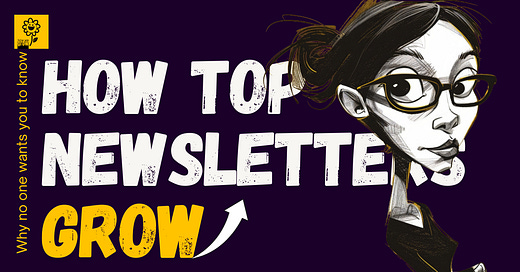I’ve spent hundreds of hours diving into the strategies of the most successful newsletters, and I’ve come across something surprising: we’ve been misled.
The mainstream advice about growing a newsletter is often vague or overly simplified.
Spoiler alert: It’s more than just creating “great content” or posting regularly on social media.
The reality? It’s a blend of strategic elements—and some that almost no one talks about because they’re either difficult to replicate or don't fit the cookie-cutter narrative.
So let’s break it down.
1. Understanding the Audience: More Than Just Lip Service
Every guide to newsletter growth talks about “knowing your audience.” It’s almost become a cliché, hasn’t it?
But here’s the controversial bit: most creators aren’t actually doing it.
They pretend to know their audience, but their content is broad and vague.
The successful newsletters? They know their readers inside out because they put in the work that most people avoid.
Take The Skimm, for example. They didn’t just randomly decide to target millennial women.
They studied
their habits
their media consumption
their pain points
and even their humor.
They didn’t guess their way to success. They built it on the back of detailed personas and tailored every piece of content to resonate with that group.
Here’s the kicker: you can't fake this level of understanding.
So many creators pump out generic content because they think it’s enough to "target everyone." But if you’re not willing to niche down and risk turning some people away, you’ll never build that loyal, raving audience.
Forget the idea of “serving everyone.” The most successful newsletters pick a lane and drive down it with unwavering focus. If you’re afraid to alienate some potential readers, you’re not niching down enough. Understand your audience so well it’s almost uncomfortable.
This post is part one of a 7 part deep dive into Portfolio Careers:
»
I quit my corporate job to become a professional juggler (Part 1)
"I Quit My Executive Role After 15 Years... to Become an Artist."
»
5 Proven Strategies to Monetize Your Substack (Part 2)
If you’re anything like me, you’ve probably had that lightbulb moment:
Upcoming posts:
1. "The Lie of Stability: Why Your 9-to-5 Isn't as Safe as You Think"
Dive into the illusion of job security and why a portfolio career can be more stable.
2. "Personal Branding Is Broken: How to Stand Out Without Selling Your Soul"
Break down the myths around personal branding and how to build a brand that’s truly *you*.
3. "Portfolio Careers Aren't Just for Creatives: How Anyone Can Build One"
Give practical steps for different professions (engineers, marketers, etc.) to start a portfolio career.
4. "The Real Cost of Going Solo: What Nobody Tells You About Solopreneurship"
Share the downsides, the loneliness, and how to overcome these challenges.
5. "Why You Shouldn't Quit Your Day Job (Yet): A Guide to Building Your Portfolio on the Side"
A practical guide for those who want to start small and transition over time.
Bonus (paid subscribers only). "14 Practical Ways to Diversify Your Portfolio Career (With Tools and Examples)"
Carrying on with our analysis now
2. Creating High-Quality, Shareworthy Content:
Is “Good Enough” Really Enough?
Now, let’s get into the heart of the matter—content. Everyone says, “Put out good content,” but what does that really mean?
Here’s the unpopular opinion: most creators are playing it safe. They’re focused on pumping out “decent” content that checks the boxes but lacks the edge to be truly shareworthy.
From what I’ve seen, top creators take risks.
Look at James Clear. His 3-2-1 newsletter is simple: three ideas, two quotes, and one question.
Yet, it's packed with insights and reaches over 3 million people weekly. How?
He’s not afraid to tackle big concepts and break them down into digestible pieces.
His content isn’t just good—it’s bold, thought-provoking, and makes the reader pause and think, “I need to share this.”
And that’s the trick. The goal isn’t just good; it’s impactful.
But here’s a bitter truth I’ve found: if your content is just “good enough,” you’re still in the noise.
Tim Urban from Wait But Why publishes only a few times a year. His content is so exceptional that when he does drop a new piece, people stop everything to read it.
This is a hit because it breaks the internet rules and wins! Here’s what makes it so awesome:
Unique Content Style: Urban tackles deep, complex topics with a mix of humor, long-form articles, and quirky stick-figure illustrations that make heavy stuff fun and relatable.
Commitment to Quality: He’s all about “10X content”—creating pieces that are ten times better than anything out there, backed by extensive research and supported by a loyal Patreon community.
Smart Monetisation: From viral social media posts to selling eBooks and merch, Urban grew his platform without sacrificing his voice, turning readers into a dedicated fanbase.
Simply put, it's a masterclass in blending depth with fun!
Urban’s approach screams, “Quality over quantity,” and it’s a slap in the face to the typical advice of churning out weekly posts to stay relevant.
You don’t need to publish constantly, but you do need to make every piece count. Don’t settle for “good enough.” If your content isn’t bold, edgy, or thought-provoking, it will get lost in the sea of sameness. Dare to be different.
3. The Myth of Consistency: Is It Really the Holy Grail?
Here’s where things get interesting. Consistency is a buzzword thrown around as if it’s the golden ticket.
“Show up every week,” they say. But from what I’ve observed, this advice is misleading.
Consistency alone doesn’t cut it. If you’re consistently mediocre, guess what? You’ll get consistent mediocrity in return.
Tim Urban doesn’t publish every week, and yet his audience remains hooked. Why? Because they know when he shows up, it’s going to be worth it.
Sahil Bloom did something similar. He focused on delivering insanely valuable content and building his brand before worrying about how frequently he was posting.
When you prioritize depth over frequency, you build anticipation, and your audience will wait.
Consistency is a tool, not a crutch.
Consistency matters, but only when paired with exceptional quality. If you’re showing up just for the sake of it, you’re wasting both your time and your audience’s.
Create content that’s worth the wait, even if that means publishing less often.
4. Connections: The Overlooked Growth Lever
Now, let’s talk about the one thing no one wants to admit: connections are often the hidden superpower behind successful newsletters.
Everyone loves the “lone genius” story, but it’s far from the truth.
The creators I researched didn’t rise to fame alone; they built relationships strategically.
Best way to be a part of a community is to create your own.
Connections with Your Audience
The most successful newsletters don’t just talk at their audience—they build a community around them.
Think of Taylor Swift. Yes, she’s a musician, not a newsletter creator, but her approach is telling. She replied to every Tumblr comment in her early days, making her fans feel seen and valued.
Newsletter creators like James Clear do the same, replying to emails and engaging in conversations. These aren’t just followers; they’re fans who promote the content for free.
But here’s where many creators miss the mark. They think engagement is optional. They’re so focused on gaining new subscribers that they overlook the ones they already have.
This is a critical mistake. If you’re not nurturing your current audience, why would they ever recommend you?
Connections with Peers: The “Secret Club” No One Talks About
Let’s pull back the curtain.
Many successful creators form strategic peer groups. Dickie Bush, for instance, didn’t just create content and hope for the best.
When he had only 1,800 followers, he formed a group to write every day for 30 days.
That group became Ship 30 for 30, a multi-million-dollar business.
He and his business partner Nicolas Cole, have now brought together thousands of students who might not otherwise have met one another, including myself











